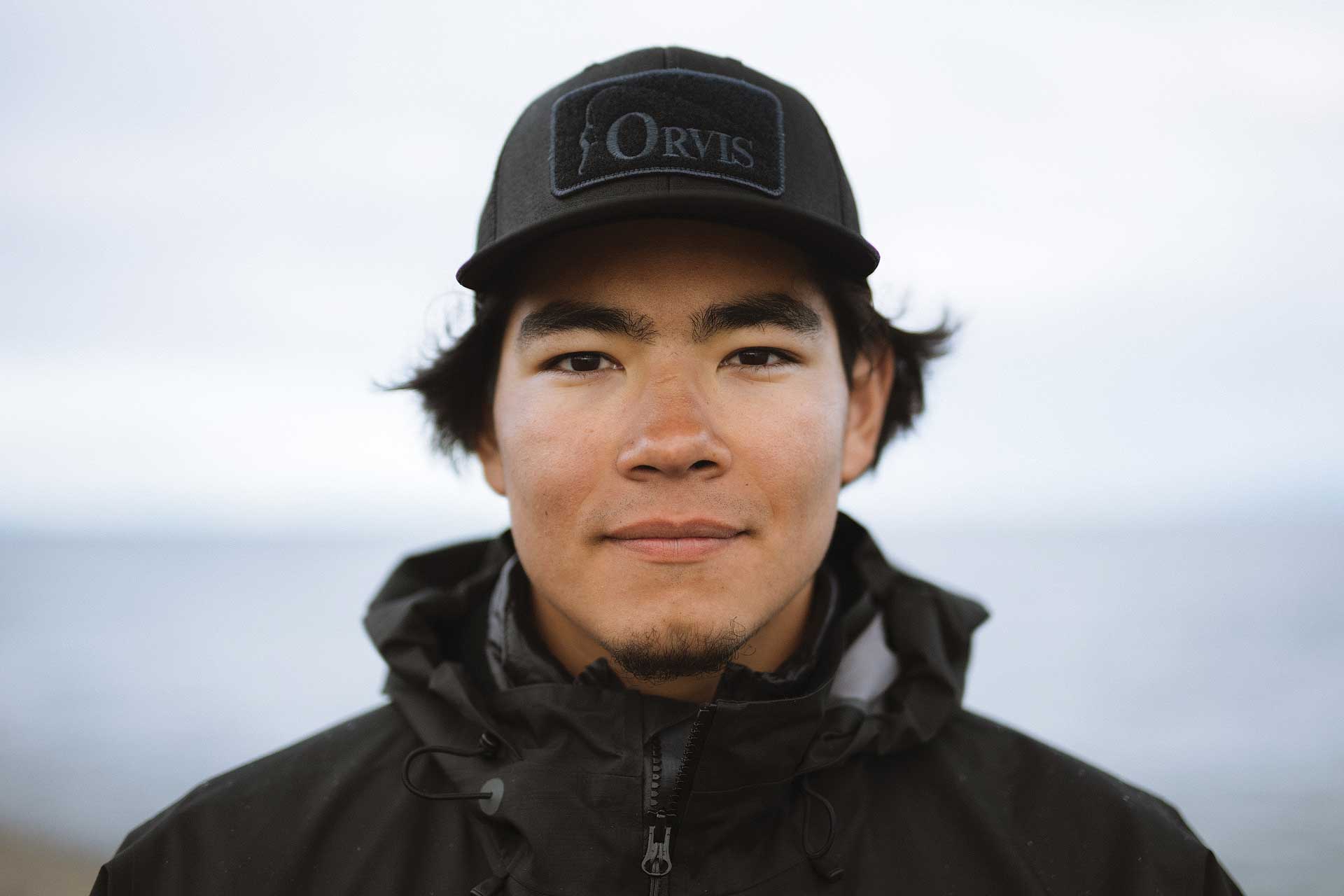
Photo by Colin Arisman
By Daniel Ritz
How Bristol Bay Fly Fishing & Guide Academy graduates are redefining fly-fishing travel culture in Alaska.
Rounding a blind bend in the Brooks River, the nearly 900-pound brown bear surprises us as it sits haunches deep, ripping into the belly of a bright red 8-to-10 pound Sockeye salmon buck.
“We’ll need to go around,” Triston Chaney, my guide, tells me. In Katmai National Park, anglers must maintain a minimum distance of 50 yards from bears. Believe it or not, that is often difficult.
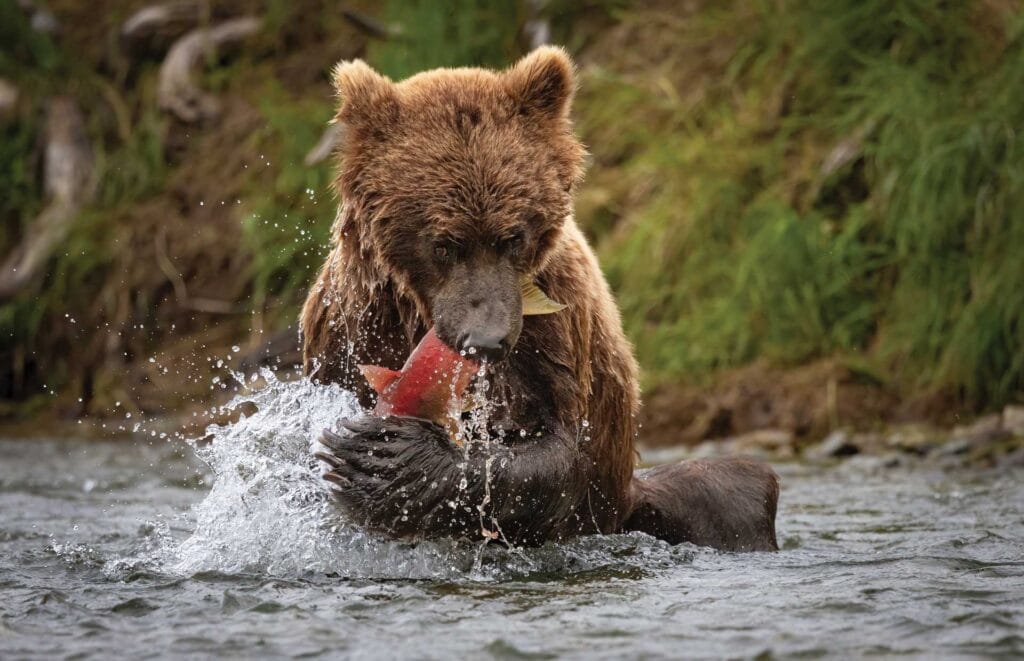
Now 24-years old, Chaney began fishing on his grandpa’s gillnet boat in Bristol Bay at nine years of age. His father taught him how to fly fish and before the commercial fishing season Chaney and his family still put out a beach set-net to gather food for the year to come.
“That’s Brooks for you. Man, I love this river. The fish are epic, and I mean, look around,” Chaney, whose family is Yupik and Athabaskan, giggles as we circumnavigate the bear who beat us to our hole.
I take note of this subtle paradigm shift. Chaney, without exception, refers to Brooks River, and the fish within it, personally.
Not “the Brooks River” like a southern California highway.
It was a living entity with character, attitude and personality that he knew well.
Nanci Morris Lyon
Nanci Morris Lyon is the owner of Bear Trail Lodge and the lead instructor of the Bristol Bay Fly Fishing & Guide Academy (BBFFGA) since its inception in 2008.
Photo by Sarah Miller
“The BBFFGA is the crowning glory of what I feel lucky to say has been a long, fulfilling, life,” Lyon tells me from below the neon sign appropriately reading “Nanci’s Bar.”
Lyon joined Luki Akelkok and Tim Troll to start the BBFFGA, with goals to enable Bristol Bay youth to pursue sportfishing jobs in their own community. The Academy has empowered more than 150 future guides to share local culture and conservation challenges with visitors to the region by training not only in fly-fishing skills, but also customer service, land management, fisheries biology, lodge business management and more.
“My Academy students are by far the most requested guides on my staff,” Lyon continues. “These kids know all about where the fish are and better than that, they know all the things about the history of the people and the area—where the moose hang out, how to trap beaver. The other stuff, that’s the easy stuff to teach: what fly to tie on, what sink tip to use. These kids grow up knowing where the fish are, how the rivers behave, where the rocks are. Saves me a lot of money in boat repair!”
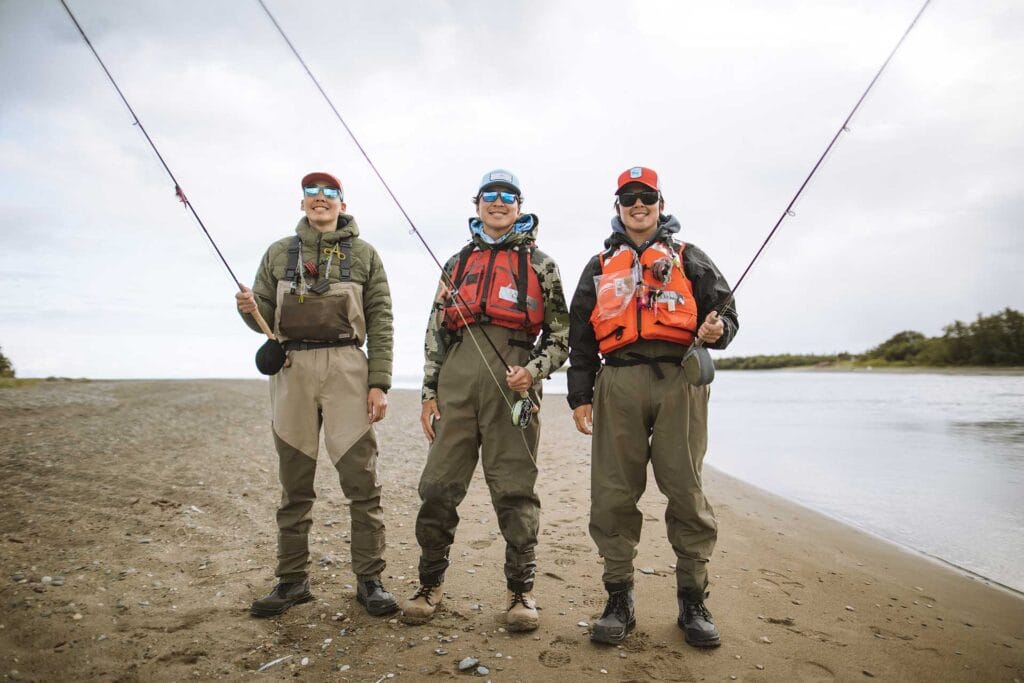
Not only producing top-of-class guides, the Academy, with support from program partners the Bristol Bay Heritage Land Trust, Bristol Bay Native Corporation, Trout Unlimited – Alaska and the Bureau of Land Management, continues to garner interest from around Alaska and the Lower 48 for inspiring community bonds.
“We’ve had elders come to us at the Guide Academy, and speak to the kids, who acknowledged there may be room for sportfishing and that their kids could be the ones to make that happen,” Lyon responds, fighting back tears. “That’s a bridge I never saw being built. It’s done immeasurable things for melding this community.”
I ask Lyon how she judges BBFFGA and its role in the success of Bear Trail Lodge.
“It isn’t without its challenges, because a lot of these kids have other commitments. They might need to work the commercial season or they have family net permits they need to help fulfill. Is it worth it? Absolutely. The people appreciate it and it gives these kids a lot of options for their future and their families. I guess the question is: How do you measure success? For me, I work with my neighbors, we respect each other and we look out for each other. Maybe it’s not crucial for financial success, you could run a lodge another way, but my success wouldn’t mean anything to me unless it was built that way.”
Rylie Booth
Rylie Booth, 23, is Lyon’s daughter and was born in Bristol Bay. Nowadays, she manages the guides and many of the logistics at Bear Trail Lodge.
“I remember the looks I would get from people,” Booth shared, remembering her first full-time guide season in 2018. “It was shocking. I never expected the surprise of people that I was so young, and female. I’d been here my whole life and I was confident in what I was doing. There was more than once I had to remind folks to ‘buckle-up, boys, because I’ll be leading you into the wilderness tomorrow.”
“I love the diversity of it (the guide staff),” Booth says,” and our clients regularly give us that feedback. Our guides’ ability to share the history, culture and yes, their locally honed talent, means a lot to us, a lot to our guides and a lot to our clients.”
“I think it’s important to put your money where your mouth is. Remember that where you’re putting your time, your effort, your hard-earned money into an experience is allowing someone in that community to come home and put food on the table,” Booth said. “This can be a way of giving back. Your engagement doesn’t have to be a donation. You’re getting something back, something beautiful back.”
Kvichak Aspelund
Kvichak Aspelund, 26, grew up in King Salmon, Alaska, a country mile from where Bear Trail Lodge stands above the banks of Naknek River. After graduating from the Academy in 2013, Aspelund has worked as a full-time guide at Bear Trail since 2019 after graduating from the University of Anchorage.
“Everyone lives here. It’s hard not to drive down the road and see a cousin,” Aspelund, whose family is Aleut and Athabascan, says. “My Grandpa’s 91-years old and still tries to go moose hunting. We’re working on getting him to settle down, just a bit.”
“I tell guests things like ‘That’s old Smiley’s cabin, he used to trap down here.’” Aspelund admits, “Then, back at the lodge, I’ll hear that story being shared with other guests or the staff just as often as they talk about the fish they caught.”
Aspelund feels a responsibility to continue to look out for the future of the increasingly busy Naknek and surrounding fisheries, despite admittedly not knowing the answers of exactly how to do so in a rapidly changing world.
“Local guides, me, Triston, Riley, Reuben, I think our connection adds something to the experience and our concern for the area helps balance the use and the pressure on the rivers and the fish,” he says. “I’m happy here, but not just as a guide, I believe in what Nanci believes in, the ways that this lodge connects with the community. It’s the little things that go a long way. It’s an open invitation for anyone in the community to come over for dinner. It’s the fundraising that Nanci does for the local schools, the school I went to growing up, even though she doesn’t have kids in the school.”
“I hope people come out and appreciate my home for the way it is,” Aspelund shared. “The eagles, the bears, the rivers and all the things, even Pebble Mine and stuff like that, too. It’s all connected and it’s crucially important people recognize how important it is they make these things important to them.
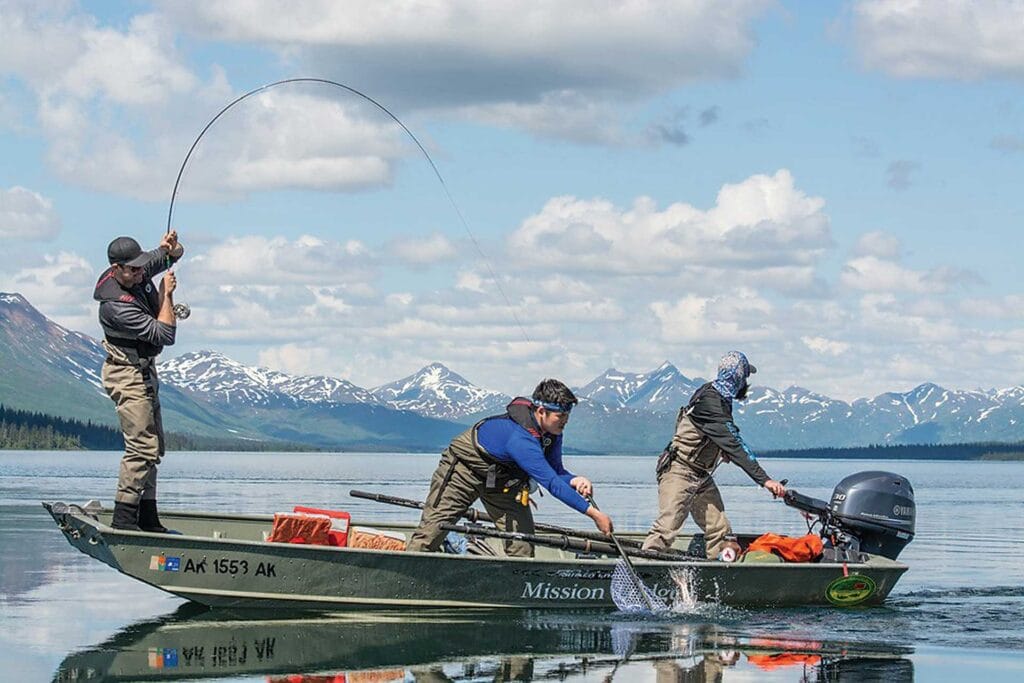
“I think a lot of our clients find themselves immersed and lost in the experience of Bristol Bay when they go with one of our Guide Academy students,” Lyon says. “They become entrenched in more than fishing, they forget about their goals they had when they came here.”
Truth be told, I had come to Bear Trail with the explicit goal of connecting with an Arctic char—the 20th and last of the currently available native trout (and char) species of the western United States I had connected with—and closing the book on my Western Native Trout Challenge series.
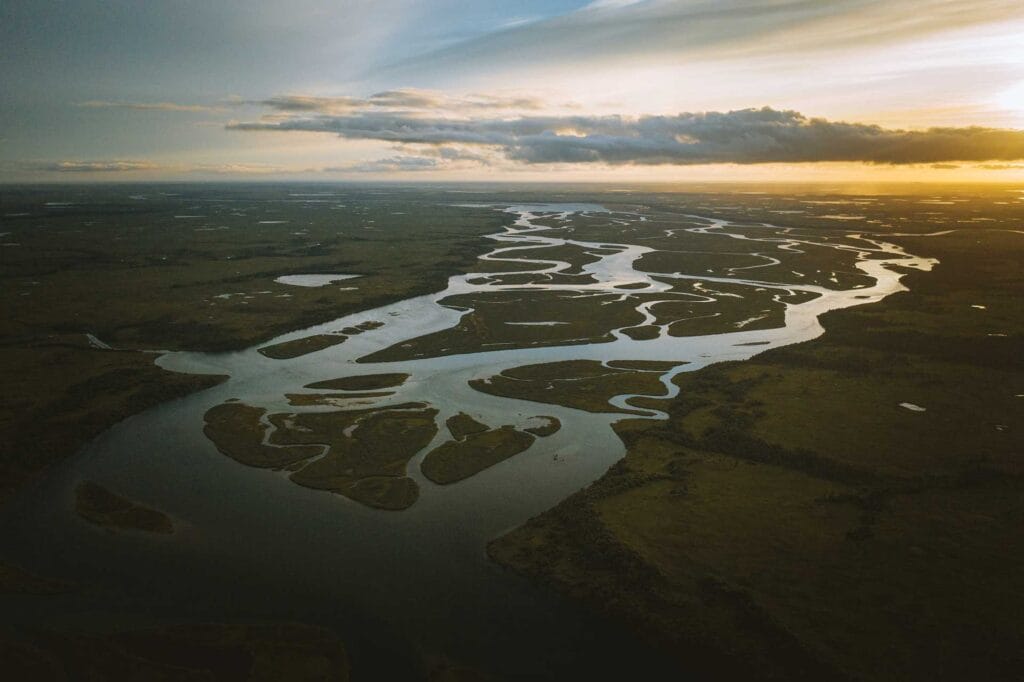
In true bottom of the ninth style, hundreds of miles south on the Alaska Peninsula, the hours raced by as Chaney, my fishing partner, Thomas, and I sorted through sockeye in hopes of finding the elusive Arctic char at a lake outlet stream.
“They’re here,” Chaney repeated confidently each time I walked back up towards our plane to take yet another run through, “we just need to find them. Try the bend, wade far out. It gets deep, but the current isn’t too fast. There’s a big salmon bed out there and they’ll be behind it.”
I waded out to within inches of the top of my waders.
“BIG CHAR!” Chaney screams from the bank as the line went taught on the first drift, my 8-weight bending to the cork and the reel screaming.
After wrestling the hefty char to the bank, Chaney and I hug and slap loud high fives before resuscitating and releasing her back into the current,
I sink to my knees in the middle of the river, attempting to take in the moment and savor every detail of the long awaited moment.
“Soak it in, Daniel. Soak it in,” Chaney chuckles, looking back from the bank with a smirk.
“I wonder if he knew they were there all along,” I think to myself, matching Chaney’s radiant smile.
I’m sure he did.


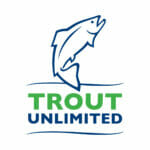
Comments